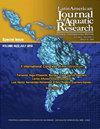墨西哥湾南部坎佩切海岸搁浅的海洋生态型 Tursiops truncatus 的总体健康状况:多学科分析
IF 0.8
4区 农林科学
Q3 FISHERIES
Latin American Journal of Aquatic Research
Pub Date : 2024-02-29
DOI:10.3856/vol52-issue1-fulltext-3078
引用次数: 1
摘要
搁浅提供了有关稀有海洋生物及其与环境关系的宝贵信息。在墨西哥湾南部,特别是墨西哥坎佩切中部海岸,很少有海洋鲸目动物搁浅的记录,因此生物信息也很少。2022 年 9 月 7 日,坎佩切省塞巴普拉亚海岸发生了一起罕见的搁浅事件。经鉴定,该标本为雌性 Tursiops truncatus,具有海洋生态型的形态特征。尸体在死后不久就进行了检查,用于不同分析的样本都是新鲜采集的。采集了组织样本,并进行了一些特殊观察,以确定个体的总体健康状况。分析结果显示,肝脏、肺部和肾脏受损,这可能与 1) 该生物的高龄(大于 35 岁)和 2) 体内存在持久性有机污染物有关。最重要的是,这项研究有两项新发现,即首次记录到寄生虫疟原虫,以及在墨西哥湾南部的T. truncatus海洋生态型中发现肾结石。本文章由计算机程序翻译,如有差异,请以英文原文为准。
General health status of a stranded Tursiops truncatus of the oceanic ecotype in southern Gulf of Mexico, Campeche coasts: a multidisciplinary analysis
Strandings provide valuable information about rare marine organisms and their relationship with their environment. In the southern Gulf of México, specifically on the central coast of Campeche, Mexico, strandings of oceanic cetaceans have rarely been recorded, therefore, biological information has also been scarce. One of such rare stranding cases occurred on September 7, 2022, on the coast of Seybaplaya, Campeche. The specimen was identified as a female of Tursiops truncatus with the morphology features of the oceanic ecotype. The carcass was examined shortly after death, and samples for different analyses were obtained fresh. Tissue samples were collected, and some particular observations were made to define the individual's general health status. Results of the analyses revealed damage in the liver, lungs, and kidneys, probably related to 1) the advanced age of the organism (>35 years), and 2) the presence of persistent organic pollutants. Most importantly, this study contributed two new findings, the first record of the parasite Anisakis and the presence of renal calculi in the oceanic ecotype of T. truncatus in the southern Gulf of Mexico.
求助全文
通过发布文献求助,成功后即可免费获取论文全文。
去求助
来源期刊

Latin American Journal of Aquatic Research
FISHERIES-MARINE & FRESHWATER BIOLOGY
CiteScore
1.70
自引率
10.00%
发文量
44
审稿时长
4-8 weeks
期刊介绍:
Latin American Journal of Aquatic Research- LAJAR is the continuation of the journal Investigaciones Marinas (1970-2007) and is published since 2008 by the Escuela de Ciencias del Mar, Facultad de Ciencias del Mar y Geografía of the Pontificia Universidad Católica de Valparaíso. LAJAR is an “Open Access” journal that publishes in English language, original research articles, reviews and short communications on aquatic science, which contain the results of research conducted in aquaculture or in oceanic and coastal marine waters of Latin America.
The following topics are considered: Physical Oceanography, Chemical Oceanography, Marine Biogeochemistry, Marine Pollution and Toxicology, Marine Geology and Geophysics, Biological Oceanography, Fisheries and Aquaculture.
 求助内容:
求助内容: 应助结果提醒方式:
应助结果提醒方式:


